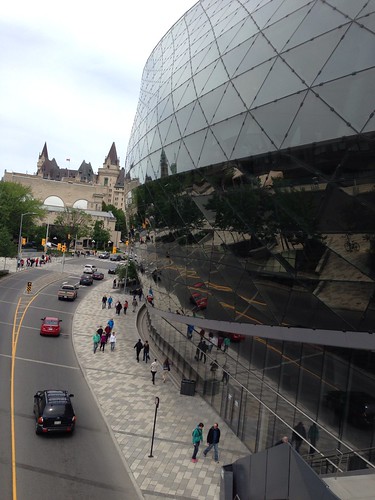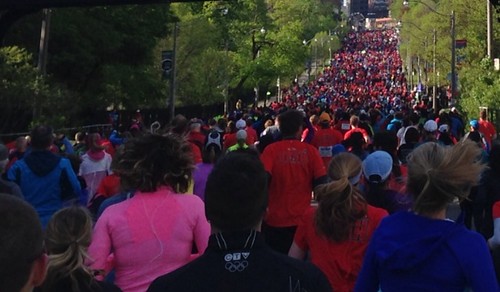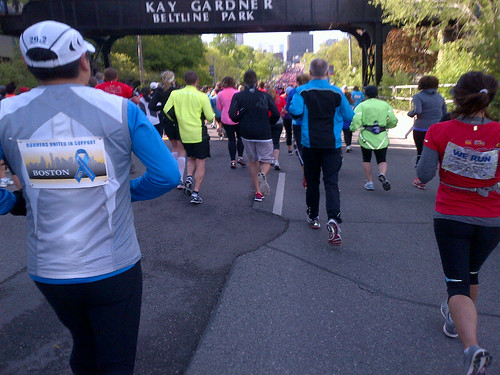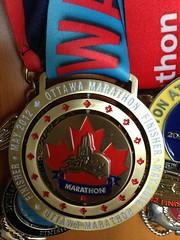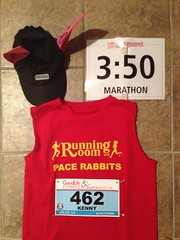I singled out the blue bibs, catching the names of runners and yelling them out as to-be marathoners passed me in the final hundred metres of a 42.2K journey. "Go Michael, you got that Marathon!" I'd shout while clapping, hoping that the message would get through his earphones, or the grimace. I saw the names go by -- Bob, Emily, Matthew -- people I'd never met but I cheered all the more loudly as 5K runners hotdogged their way past our long-distance compatriots. A moment of cheer sometimes got a wave, a split second of reprieve from a silent struggle.
"I'm saving all my cheering for the marathoners," I told my friend Lee who had also to come cheer runners. I've been there, just an hour earlier, leading a pace group in. Fellow marathoners know what it's like to be there.
Hours later, the moment I heard a
runner had fallen, my heart sank. And as the minutes flew by, and I learned more about
Emma van Nostrand, I felt deflated. Part of me felt defensive -- and unsurprisingly, yes, I got a few comments from friends a day later who claimed runners are crazy, our sport is nonsensical and that marathons are dangerous. I brushed that aside with a laugh. I'd heard those arguments before.
I was shaken by her death. As the picture of Emma emerged -- through her Vines,
Tweets, past
race results and
reports of her death I've read in media -- I knew that we had lost a fellow runner attempting her first marathon.
 |
| Final kilometres of the Toronto Marathon |
The marathon is a special race -- we all follow the same paths, every step of the way. On Sunday, I passed the same point where she collapsed. It was a day of joy -- because our sport is more than just competition, it's also about a celebration of personal achievement or milestones that we set and complete.
Emma was one of us. She was a bundle of nerves in the hours
leading to race start, she went through
her taper and many months before that, in late November, when most of us spring marathoners were in our off season, she kicked off her training for Toronto with her cousin back in Cape Breton.
Andrew McKay, a fellow runner who made the 911 call after he saw Emma went down, wondered aloud why her results were wiped
from the race results. I wondered why she was removed from the photo site. But I've seen the pictures of her and her mom and cousin, and what stuck me is pure joy. A double thumbs up she gave the photographer as she and her cousin Faye were running down Rosedale Valley Road, a smile on her face as she ran out on the Martin Goodman Trail, my home course. It was a similar smile I shared with my pace group on the same trail.
 |
| Joy. |
Tonight, I'm also thinking of Danny Kassap, an elite runner who
passed away a day after the Sporting Life 10K in 2011. I later found out where Danny was buried, among the running paths of Mount Pleasant Cemetery, a place where I'd give a silent nod on the few times I passed it,
seeing medals draped over his memorial.
Emma died on my home trail and I'll be thinking of her when I pass where she fell. When she went down, runners immediately came to her aid. She wasn't alone. The last time I ran the path, we led runners on their way to a goal. Next time, I'll carry her in my thoughts, carry in her memory through the final three kilometres of a race she couldn't complete.
She came from a family of runners. Her dad, who just ran Boston, told the
Toronto Star about her tenacity and gave this quote that left me so heartbroken. Maybe only a runner gets it.
“If she picked a goal, then she was going to make it happen some way or another,” he said. “That probably would be her biggest disappointment, that she wasn’t able to finish that marathon.”
Emma, we got this. Rest in peace.


